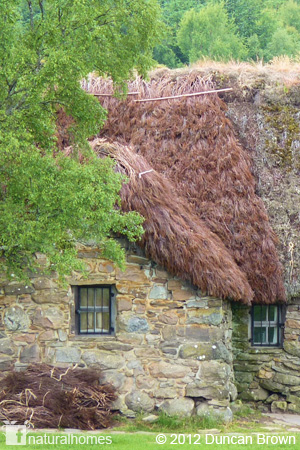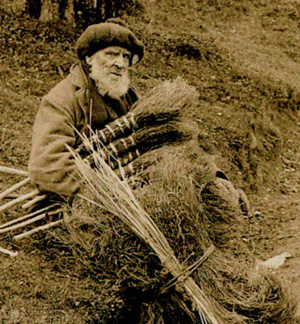 |
|
Over the years the cottage has changed shape but
leaving signs of earlier construction like the single cruck frame
which survives embedded in the
western gable. The eastern gable is a heather turf wall The roof
may have originally been thatched with straw using a
clay-thatching technique however straw may have been too
valuable to be used for thatch. Today the little cottage sports
a wavy haircut in the distinctive colours of heather. The picture
left shows the thatching in progress with bundles of heather,
ready for the roof, lying on the ground below the window. John
Warner of
Brandon Thatchers, a heather thatcher, says heather was once a
status symbol amongst the rush thatch cottages of small
communities and was often used for the priest's home. Wind blows
through heather so it must sit on two layers of turf underlay. The heather is a first line of defence
shedding much, but not all of the rain. The heather stalk is tied
down with
brier
and stuck with clay (mud). |
|
| |
 |
|
|
more thatched
natural buildings |
|
|
|
|
|
Amongst the types of thatching
material heather fares well lasting 20-30 years. The life of other
thatching materials are: Rush 3-5 years
Bracken Root 5-10 years
Heather 20-30 years
Reed 30-50 years
Eelgrass 200-400 years The heather used for thatching needs to be 3-4 feet
in length. Heather of that length is found growing on the north
facing slopes of the highlands. To harvest the plant you must peel
the heather back from the direction it grows otherwise pulling it up is
very difficult. Finding heather of this length is not so easy
because land owners burn the heather to keep it under control,
when heather was a natural harvest for thatch, burning may not
have been
necessary.
|
|
There are over 10 million acres (400,000+ ha) of heather in
Scotland. Other than thatch heather has many other uses that you
may not know about including
heather ale, baskets, brushes, pot scrubbers and doormats.

Scottish heather broom maker, circa 1900 |
|
A note on bracken thatchingBracken thatch requires air to circulate from the home below. Even a
standard breathable membrane is not enough ventilation to prevent
the lower layers from rotting. When bracken is laid green the fronds weave themselves together
creating an interesting texture. Bracken thatched cottages are few
and far between but there is one at the
Highland
Folk Museum in Newtonmoor, Scotland and another at
The Roundhouse Project in Wales. Here's an excerpt from 'Tales from the Green Valley'. Six
minutes into the video they start to use bracken for a thatch
underlay.
|
|